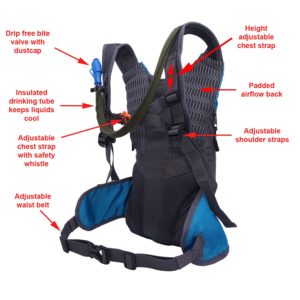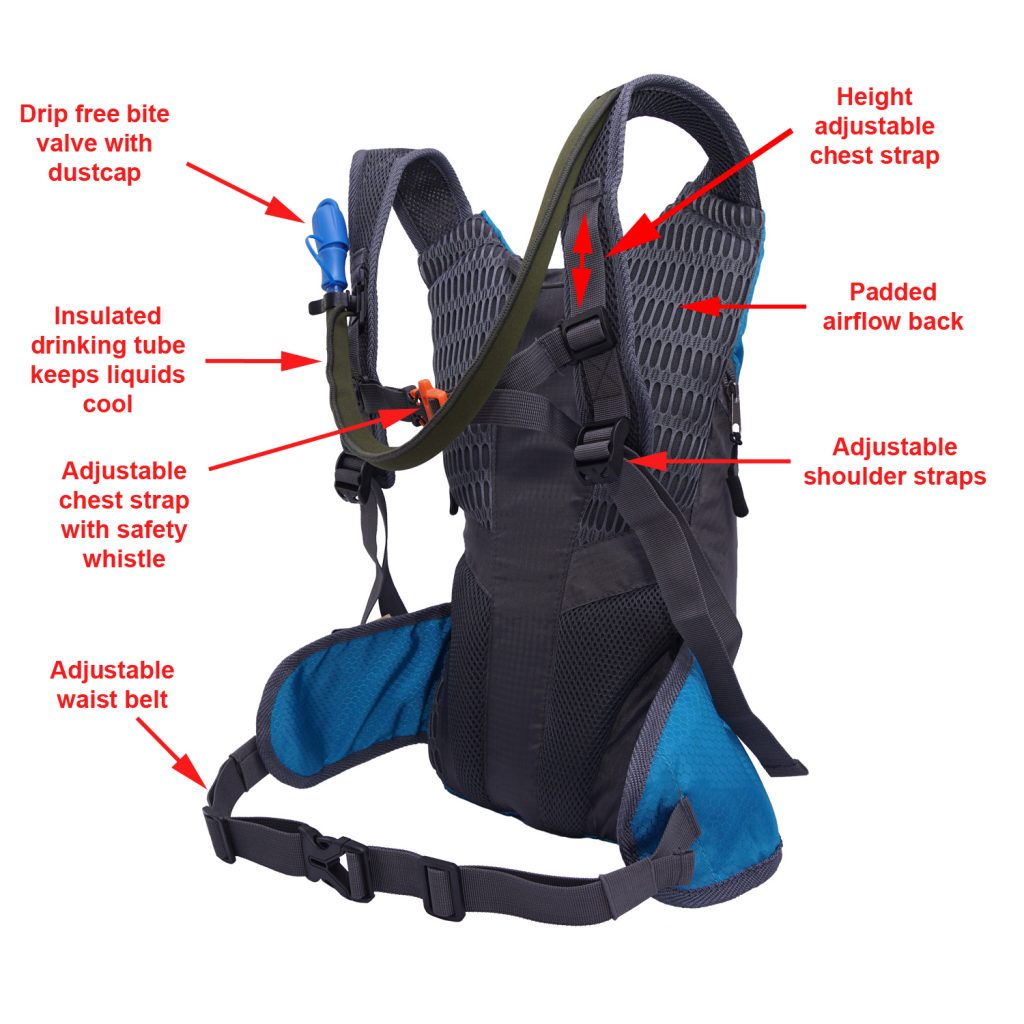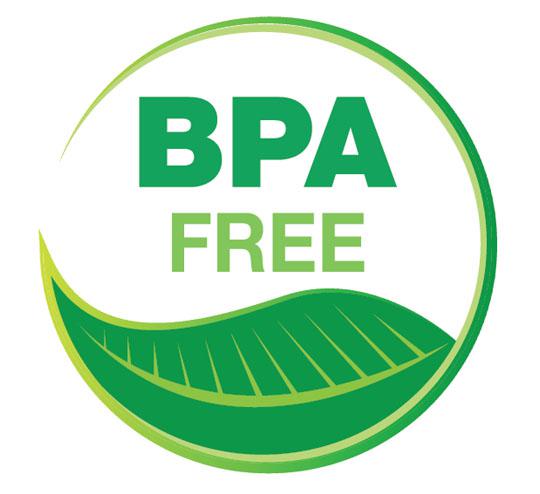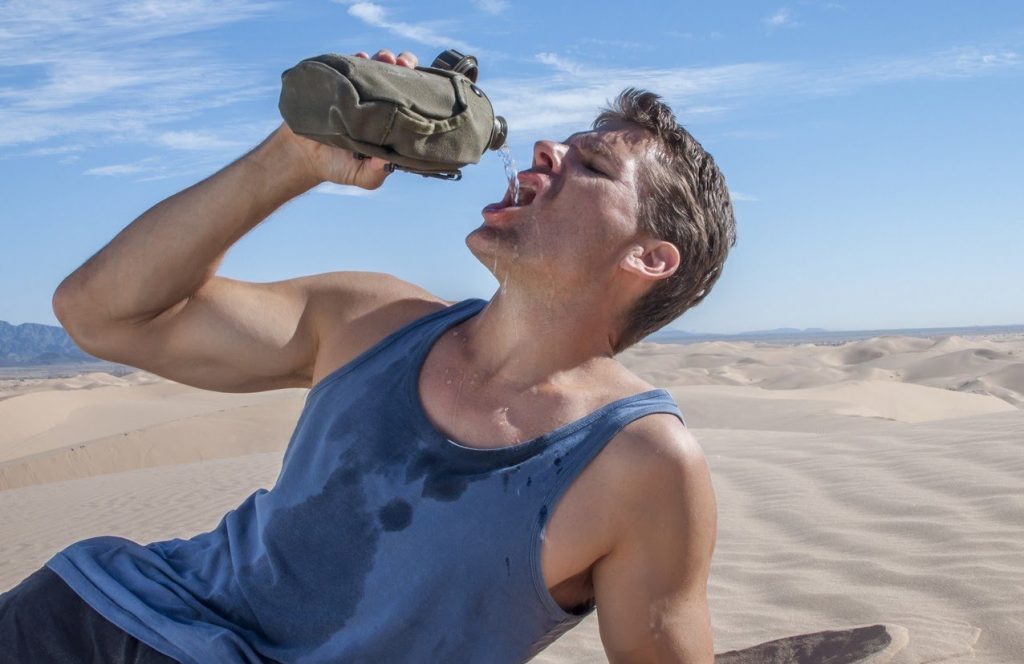Sports Hydration Pack Buying Guide – Helping You Choose The Right One
Choosing the right hydration pack is not obvious, but there are many factors that can help you find the perfect hydration pack for your needs.
What is a Hydration Pack?

Hydration packs have become very popular in recent years as more and more athletes are going for longer training courses. Also, they grew in popularity among soldiers fighting in dry and arid conditions.
The original users of hydration packs, however, were mountain bikers and motocross riders. Hydration packs freely allow riders to hydrate hands while keeping your hands in contact with the bars of his bicycle.
The ability to hydrate without interruption has allowed many sports, besides motocross, the opportunity to push further and go longer. And staying hydrated while doing so.
Hydration packs have become an essential part of many sports box tools used by top racers, triathletes, and others. They offer a convenient way to fill up with fluid which does not just need to be water.
Today, the leading company and producer of hydration packs is Camelbak. This company was lucky to get a contract with the government early on to supply the US military with hydration packs that worked with the standard edition that many soldiers, sailors, and marines regularly use.
What Do I Need To Consider When Choosing a Hydration Pack?
- Sports Activity
- Reservoir capacity
- Cargo volume
- Size and fit
- Protection
- Your gender/age : Male , Female, child
Recommended Capacity Based On Sports Activity
- Hiking and Climbing: 70 oz (2L) to 100 oz (3L) reservoir with large cargo capacity.
- Runnning: 50 oz (1.5L) to 70 oz (2L) reservoir , no cargo capacity.
- Mountain Biking: 70 oz (2L) to 100 oz (3L) reservoir, small to large cargo capacity
- Snow sports: 70 oz reservoir (2L) reservoir, with insulated tube
- Kayaking: 70 oz reservoir, with rain cover
Reservoir Capacity

Each sport activity requires different volume of water to keep getting hydrated. The volume of water you will need depend not only of the intensity of the sport you are practicing but also of the length of your practice.
For mountain biking, It is highly recommending to get a 100 oz bladder (3L) even if a 70oz bladder (2L) could work for shorter rides.
Excepting for running, which needs very lightweight bag, 50oz hydration bladder are not recommended. In general, 70 oz bladder will fit most needs.
Cargo Volume
While running hydration packs require no cargo capacity to provide a better comfort while running, it is important to have a sufficient cargo capacity while hiking and climbing. People doing mountain biking may need some cargo capacity for the tools, helmet however some people would prefer a lighter pack. Its up to each person to get the cargo capacity to meet its needs. However, be careful before buying your pack, as some just include enough for the hydration bladder and essentials (keys, wallet, cellphone).
Size and Fit

Unlike clothing bought in a store, hydration packs do not generally come in a range of sizes. Some are, however, specifically designed for women and children. Depending on the size and volume of the hydration pack, they can be fitted with shoulder straps, waist straps and chest straps, all of which are adjustable. In general, most hydration packs will have enough adjustment to fit your shape and size.
Genre
It is possible to find hydration pack for women especially adapted to the female morphology to provide more comfort, like the hydration pack for women Nathan Intensity. There are also bags for kids, adjustable and adapted to their size.
Final Words
Having read our Sports Hydration Pack Buying Guide, you should now be in a position to choose the best hydration pack for your particular sport or activity. Take a look at our
homepage again and choose your sport from the list there.
 Each sport activity requires different volume of water to keep getting hydrated. The volume of water you will need depend not only of the intensity of the sport you are practicing but also of the length of your practice.
For mountain biking, It is highly recommending to get a 100 oz bladder (3L) even if a 70oz bladder (2L) could work for shorter rides.
Excepting for running, which needs very lightweight bag, 50oz hydration bladder are not recommended. In general, 70 oz bladder will fit most needs.
Each sport activity requires different volume of water to keep getting hydrated. The volume of water you will need depend not only of the intensity of the sport you are practicing but also of the length of your practice.
For mountain biking, It is highly recommending to get a 100 oz bladder (3L) even if a 70oz bladder (2L) could work for shorter rides.
Excepting for running, which needs very lightweight bag, 50oz hydration bladder are not recommended. In general, 70 oz bladder will fit most needs.
 Unlike clothing bought in a store, hydration packs do not generally come in a range of sizes. Some are, however, specifically designed for women and children. Depending on the size and volume of the hydration pack, they can be fitted with shoulder straps, waist straps and chest straps, all of which are adjustable. In general, most hydration packs will have enough adjustment to fit your shape and size.
Unlike clothing bought in a store, hydration packs do not generally come in a range of sizes. Some are, however, specifically designed for women and children. Depending on the size and volume of the hydration pack, they can be fitted with shoulder straps, waist straps and chest straps, all of which are adjustable. In general, most hydration packs will have enough adjustment to fit your shape and size.





